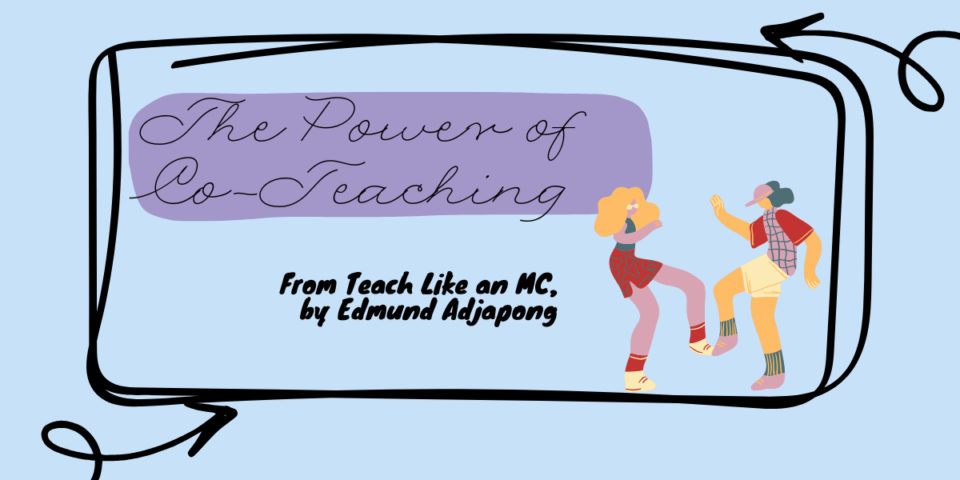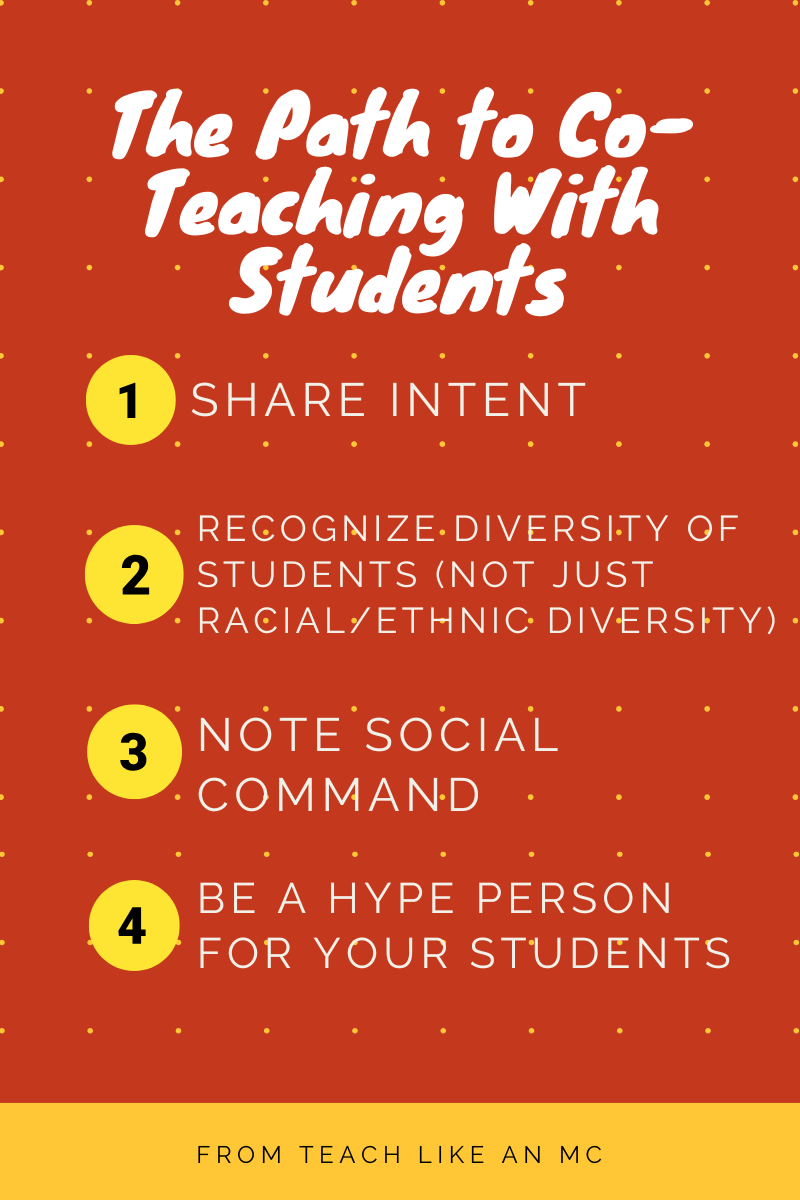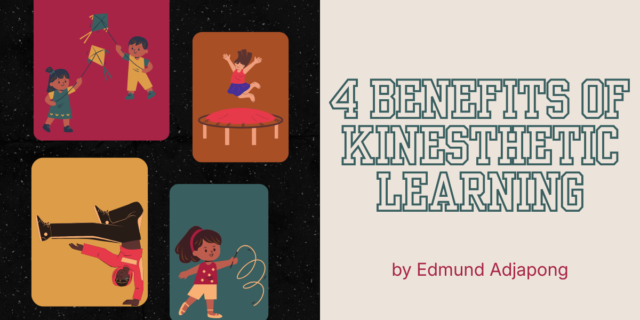
The following is adapted from Teach Like an MC by Edmund Adjapong.
In hip-hop, when an MC is performing for an audience, the lead MC is often accompanied by a fellow MC (hype man/woman) whose essential role is to support the lead MC. For a hype man/woman to be effective, they must have a deep understanding of the musical content of the lead MC. Co-teaching with your students provides the opportunity for them to showcase their mastery of the content while serving in the role of a hype man/woman in support of the lead MC (the teacher), and ultimately supporting their peers in gaining that same level of mastery.
Through co-teaching, the teacher and students will be able to work collaboratively to engage students in content. The goal of implementing this approach in a classroom is to allow the responsibilities for instruction to be shared between the two professionals. For this strategy, the student is identified as a professional and expert in the classroom. As the responsibilities for instruction are shared between both the teacher, who is normally viewed as the main authority figure of the classroom, and the student, the student feels a sense of empowerment and excitement that can allow them to take responsibility for their own learning and participation to enhance their, for example, science content knowledge.
Identifying Student MCs
We all have natural MCs in our classrooms. Sometimes, we call them the alphas of the class or instantaneously recognize them as the students who are most charismatic. Sometimes, they are the most academically inclined students and other times, they present themselves as the offbeat class clown. These are the students who have a seemingly natural command of the class’ attention on most, if not all, days. Identifying these students and celebrating their gifts will support a Master of Content on their journey to co-teaching with students. Identifying the MC can elicit critical insight into what’s working in the class and what requires attention.
Figure 3–2 (below) shows the four key steps to identifying your co-teachers and leveraging that relationship to uplift your students.

- Be honest with your students about your intent in finding fellow MC(s). While monitoring student progress in a lesson, be attentive to how your potential MCs may be communicating with other students. What and how do they communicate feedback, directions, or next steps to their peers? Are they condensed? Do they offer models? Do they use a particular word or type of language, such as comparisons and analogies, to make themselves clear or explain a concept? Do they use humor to make a point? How do their peers receive this type of communication? Be curious about your MC’s crafty communication style.
- Recognize your MCs are not one-size-fits-all. True to its Jamaican origins, the MC may be reflective of a student who is rhythmic with words, funny in nature, or charismatic in character. Ironically, the student you may initially believe to be the MC may not be appropriate for the role or may not want to do it. You may also be inclined to select a natural student leader whom you already have a relationship with. It is important to note that part of identifying your MC requires recognizing any bias that may surface, such as believing one student being better equipped to step into the role than others. Masters of Content acknowledge that the student MC may not necessarily be a student they are naturally inclined to build a relationship with.
- Recognize your MC’s powerful social moves. Take notes on how your MC moves socially in the school. In what ways does the MC leverage their influence? Do they hype up another MC? Do they hype up multiple students at once? Are they usually keeping to themselves and quiet, yet use their mystery and intellect to persuade the crowd into taking action? Or is the MC comical, whimsical, and swift with questions? Do they adapt to situations or problems creatively? Or do they draw in their peers with attentive listening? Either you instinctively recognize and attempt to leverage the MC’s abilities, or you must work hard to gain the trust of your MC to successfully establish an inviting class culture. Failing to do so may mean isolating groups of students from the class environment and therefore furthering achievement gaps within the locus of your control.
- Hype up your MC. Some MCs may know their influence and how to use it, while others may not. Let them know you recognize their strengths. Name them and how they contribute to the classroom or school community. For example, you could say, “I noticed that when you participate in a group discussion, you ask questions that offer the opposite perspective. I appreciate this because it allows students to consider different points of view.”
As you aspire to become a hip-hop educator, I encourage you to embrace your role as the Master of Content, recognizing your immense power to influence and uplift your students. Just as the MC in hip-hop curates content that resonates with the audience, your task is to deliver culturally responsive and engaging lessons that reflect the diverse identities, needs, and experiences of your students. By knowing yourself, understanding your power, remaining persistent, and staying authentic, you can create a classroom environment that fosters love, joy, and liberation. Like the MC who moves the crowd, your influence as an educator extends beyond the classroom, shaping the minds and lives of your students. It is your responsibility and privilege to ensure that every student leaves your classroom feeling empowered, heard, and inspired to apply their learning to make meaningful changes in their communities and the world.

Related Reading

The following is an adapted excerpt from Edmund Adjapong's forthcoming Teach Like an MC: Hip-Hop Pedgaogy in the K-12 Classroom.

